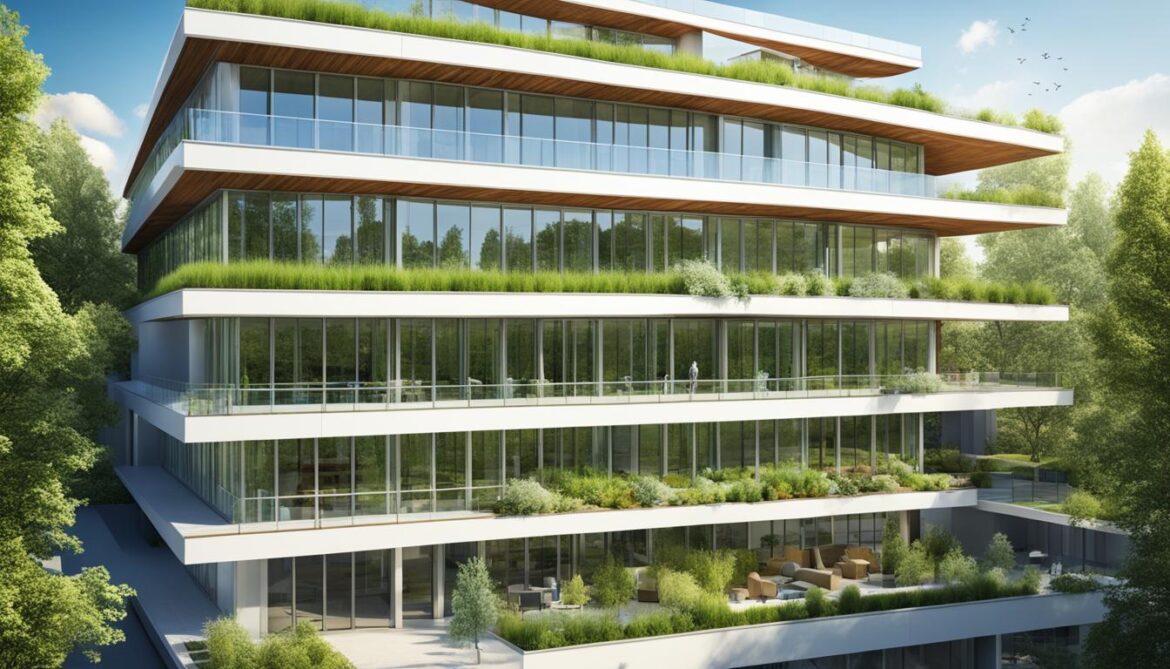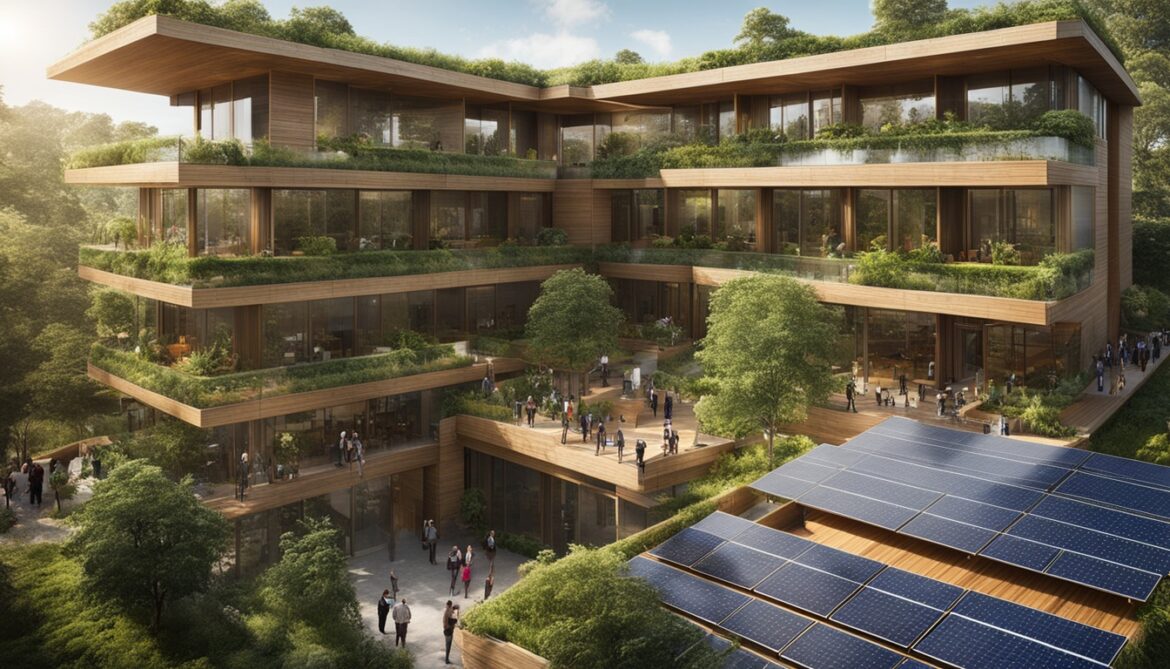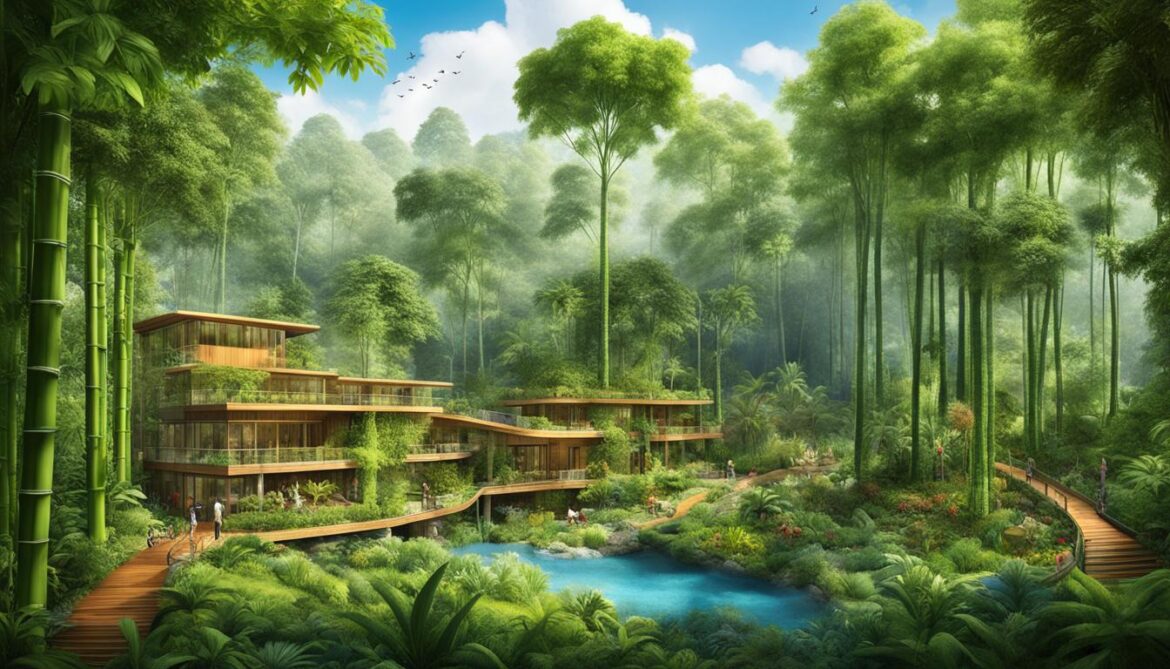Vulture populations in India have fallen by 95% since the 1990s due to a single drug in livestock. This big drop shows we need to save the planet’s variety of life. It highlights why saving species is key and often forgotten in building work. The link between green building materials and helping nature recover is crucial but not often talked about in construction.
People are starting to see how important it is to protect plants and animals. This is because of choosing the right materials in building work. By picking materials that are good for the earth and help it grow back, we can save nature. Saving nature affects not just animals but also people’s health and our money. The building world is finding it hard to get enough of natural things and meet strict rules. These rules mean using costly, earth-friendly materials and methods. Also, if nature gets harmed, it can harm our buildings, leading to high costs. So, making the right choices in building is not just good for the planet but also our wallets.
Key Takeaways
- Biodiversity preservation is crucial for human health and economic stability
- The construction industry faces challenges due to resource scarcity and environmental regulations
- Sustainable building materials can contribute to the regeneration of the natural world
- Ecosystem degradation leads to increased construction risks and costs
- The construction industry must prioritise environmentally responsible practices
Introduction to Sustainable Building Materials
Preserving biodiversity is a pressing issue. For example, look at what happened to eagle populations in India. They suffered greatly because of diclofenac, an anti-inflammatory for cattle. When vultures ate the treated cattle, they died. This tragic chain of events nearly wiped out the vulture population. As a result, the increase in decaying bodies raised health concerns for people.
The Urgency of Preserving Biodiversity
The risks to biodiversity are clear when we see the deforestation of rainforests. This action not only affects many plants and animals but also influences the planet’s climate. Urban growth and farming shrink habitats, making it hard for species to survive.
The Impact of Construction on Biodiversity
Human construction changes the landscape rapidly. It’s crucial to make buildings not harmful to nature. We must avoid ruining natural spaces whether directly or through pollution.
The Role of Sustainable Building Materials
We must act now to protect biodiversity. Using sustainable materials in building helps the environment. Plus, they save money by being more energy-efficient. This makes buildings more valuable and the construction industry more profitable.

The Biodiversity Benefits of Sustainable Building Materials
Preserving biodiversity is key for climate control and waste management. It’s about letting natural systems clean our mess. This includes air and water cleaning, oxygen production, and air humidity. The value of biodiversity for us humans is huge. So, it’s vital to preserve it. Sustainable building materials tread lightly on the planet. They help earth heal while we build, joining architecture with nature.
| Sustainable Building Material |
Biodiversity Benefit |
| Bamboo |
Rapidly renewable, supports habitat preservation for bamboo-dependent species. |
| Recycled Plastic |
Reduces plastic waste, minimises carbon footprint compared to virgin plastics. |
| Cork |
Harvested sustainably from cork oak trees, promotes eco-friendly construction. |
| Sheep’s Wool Insulation |
Renewable, biodegradable, and supports green buildings with natural materials. |
These materials show how sustainable building materials help nature thrive. They keep habitats safe and back environmentally friendly architecture.Choosing natural materials is key. It means thinking about our planet’s future. It’s about using materials that protect and preserve our world.
The Challenges Faced by the Construction Industry
The building sector is grappling with issues like less available natural resources. These include woods and specific stones from badly affected areas. This lack leads to higher costs. It’s tough to find these materials and to use them. The situation is made worse by strict environmental rules. They limit these resources further. Plus, they make it necessary to use costly but green materials and ways.
Resource Scarcity and Environmental Regulations
The state of our lands is getting worse. More land is eroded, and the earth becomes less solid. This makes building more expensive. It also increases the chance of harm to buildings. Climate change can also mess up building work. It can cause floods or make droughts worse. This might lead to spending more money. If companies don’t care for the earth in their work, they might lose customers and work chances.
Ecosystem Degradation and Its Consequences
People are more aware of climate change and tipping points now. These points are where the climate can change by itself. We must build in ways that don’t add to our CO2 problem. We should construct things that can last long. This will help fight the dangers that come with climate change.
Climate Change and Tipping Points
Looking after the troubles in construction, like the lack of resources and tough rules, is key. By doing this, the industry can help save our natural materials and habitats. This will help keep our environment good for a long time. And it will help save many species from disappearing.

Economic Incentives for Sustainable Construction
Sustainable building materials bring both ecological benefits and a boost to the construction sector’s bottom line. They lead to lower operational costs by being more energy efficient. This raises the value of properties over time, which is good news for construction businesses.
Energy Efficiency and Operational Cost Savings
Sustainable materials are energy efficient. They cut down on energy use, which lowers costs for building owners and users. This makes buildings more cost-effective in the long run, attracting developers and investors. As a result, the demand for eco-friendly building practices grows.
Building Revitalisation and Resource Conservation
Revitalising old buildings is key to saving resources and making cities better. It lets us create solutions that are good for the planet and local areas. By reusing old structures, the construction sector cuts down on waste and doesn’t need as many new materials. This approach helps the economy while keeping the environment in mind.
The Role of Politics in Promoting Sustainable Construction
Politics is key in making sustainable construction methods widely used. Construction revolution gets a big boost from it. The construction industry must keep embracing sustainable practices. This helps tackle climate change and biodiversity loss.
Leaders can use their power to push for eco-friendly construction. They do this by offering rewards and making strict rules. Natural materials are preferred, thanks to these measures. This approach helps protect the environment.
Encouraging low carbon footprint structures is something politics can do well. This influences how people see green building practices. With resources running low and nature suffering, political support is crucial. It helps us move towards a more sustainable future.

Planning for Biodiversity Conservation
When planning a construction project, we must look at the local nature. It’s important that the building work doesn’t harm the animals and plants there.
Site Analysis and Species Consideration
Before starting to build, it’s key to study the site. This way, builders can work around important times for the wildlife. For instance, they can plan to avoid building when animals are having babies or are sleeping.
Avoiding High-Value Sites
It’s best to not build too near important sites like ponds and areas where rare species live. Doing so can protect the creatures and plants. This approach allows for the creation of buildings that don’t harm nature. They can even help keep local ecosystems healthy.

Mitigating Construction Impact
Reducing a building’s impact starts from planning and goes all the way through its entire life. This means less pollution and harm to the area it sits in. A good example is building concrete parking lots close to the building instead of spreading them out. Doing so saves natural land from being covered.
Preserving Ecological Connectivity
If a building sits between two ecosystems, keeping their connection is vital. Building a bridge for animals helps them move freely. Using special concrete that lets rainwater pass through helps. This method uses less space for ponds, making the project more sustainable.

Compensating for Habitat Loss
When an ecosystem gets damaged, we can help by adding back plants or animals that need protection. This technique supports efforts to keep wildlife and their homes safe. It also aids in fixing the natural balance and in
habitat preservation through construction
projects.
Xeriscaping and Native Plant Integration
Planting native species in their usual places, or
xeriscaping
, is good for the environment. It makes existing homes for animals flourish. Drought-resistant plants benefit the area by using the water they get without needing more. This helps maintain the natural balance and improves the soil. Yet, we must be careful not to introduce plants that could harm the native ones.
Green Roofs for Habitat Creation
In places with lots of buildings, we can still make room for nature. Adding
green roofs
to structures is a great way to give back. They create spaces for plants and bugs that lost their homes. Green roofs come in three types, each suitable for different amounts of care. These roofs can grow grasses, bushes, and even trees. Such greenery helps in the survival of insects, small mammals, and birds.
This helps achieve
natural materials impact
and build

Case Study: Alice, the Eco-Architect
Alice is an eco-architect filled with zeal for making green buildings. She worked with her community on a remarkable project. They turned a run-down urban park into a vibrant home for plants and animals. This project was a big step towards a more eco-friendly and lively city.
Revitalising an Urban Park
She, along with her team, picked local plants and trees. They made sure the park was friendly to various species. Alice created paths that let people enjoy the park without harming the environment. She also added green features like collecting rainwater and using solar power for lights.
Wildlife-Friendly Design Principles
Once completed, the park became a haven for many creatures. Birds and small animals found a new safe spot. Alice’s project boosted the park’s variety of life. It showed others how to care for the earth too. Her work proved that designers could protect nature by thinking green. And by doing so, they can leave a better world for us all.

Principles of Ecological Architecture
Ecological architecture is about balancing human needs with nature’s protection. It focuses on building designs that blend with the environment. Green areas are key in this approach. They help wildlife, clean the air, and make people happier. By adding green spaces, architecture becomes both beautiful and responsible.
Integration of Green Spaces
Solar and wind power are crucial in ecological designs. They help architects use less fossil fuel and cut down on harming the planet. With renewable energy, buildings become more efficient and friendly to our world.
Utilisation of Renewable Energy Sources
Eco-architects work hard to use less energy and save resources. They do this through smart building design, good insulation, and efficient appliances. These efforts not only protect the environment but also make spaces better for people to live and work in.
Energy Conservation Practices
Preserving and rebuilding ecosystems is also a top goal. Eco-architects design buildings that help wildlife thrive. This protects our planet’s natural beauty and health.
Biodiversity Enhancement
Through including green spaces, using renewable energy, saving energy, and helping wildlife, architects play a big part in caring for our planet. They help make communities that are friendly, strong, and eco-aware.
Sustainable Building Practices in Ecological Architecture
Sustainable building practices are key in ecological architecture. They help protect the natural world. They also strengthen the link between buildings and the environment. Architects use materials that are good for the planet and systems that save energy. This reduces harmful gas emissions and cuts down on resource use. It all works towards a greener future. The perks of these methods are less harm to the environment, smarter use of resources, more energy saving, and healthier places to live in.
A key part of ecological architecture is adopting green habits. Using the sun, wind, and earth for energy, planting gardens on roofs and walls, and collecting rainwater are some ways. Designing spaces to use less heating or cooling is also a big help. These efforts don’t just lessen our impact on the planet. They help nature recover and highlight the beautiful bond between our buildings and the earth.
Choosing to build green, architects show they stand for eco-friendly ways. They aim for less damage to nature and very little pollution from their buildings. This helps keep the places where we live and wild spaces healthy. It’s all about making a future where both the city and nature thrive.
Designing with Nature in Mind
In ecological architecture, design’s link with nature is key. Architects aim to make buildings that fit well with their surroundings. They help keep natural elements like trees, waters, and animal homes safe. This makes us feel closer to nature when we’re in these places.
The goal is to make spaces where people and nature are in harmony. This approach uses natural elements and design rules. The aim is to help plants and animals thrive while making things look good. So, the result is a space that feels all in tune.
Blending the Built Environment with Nature
Ecological architecture loves to add green areas to buildings. These spots are great for animals, make the air cleaner, and help people feel good. Doing this makes buildings look even better and work with nature. It’s all about finding a sweet spot between the man-made and the natural.
Use of Sustainable Materials
In this kind of architecture, using the right materials tops the list. Architects pick ones that are easy on the environment. They choose things close by, renew easily, and don’t harm nature much. This choice helps keep our planet healthy. It also stands for eco-building and caring for our Earth. These steps make architecture more responsible.
Choosing materials that don’t hurt our planet is vital. It’s all about fitting buildings into the local nature without causing trouble. Architects choose based on what’s best for the Earth. This leads to buildings that help nature and make a better tomorrow.
Conclusion
Ecological architecture aims for a balance between human life and nature. It uses green areas and renewable energy. This helps save the environment and makes communities better places to live.
By using eco materials and energy-saving systems, architects help the planet. They reduce harm and support a future that’s more green.
Design that joins buildings with nature, like Alice does, helps people connect with the world around them. It saves plant and animal life, making our future sustainable.
Putting nature first changes the way buildings are made. It shows how humans and nature can thrive together. Architects are leading this change towards a future that is kinder to our planet.
FAQ
What are the key benefits of using sustainable building materials?
Sustainable building materials help keep our world green. They protect nature, lower our impact on the earth, and cut down carbon pollution. They make our buildings stronger and more caring for the environment.
How do sustainable building materials help protect biodiversity?
These materials stop the destruction of living spaces. They keep our natural homes safe and encourage the growth of green areas. This in turn helps animals and plants thrive.
What are some of the challenges faced by the construction industry in adopting sustainable practices?
The building world is faced with a lack of resources and tough rules. It also deals with the damage to our living spaces and the dangers of a changing climate. This all pushes them to use more costly but earth-friendly ways and materials.
What are the economic incentives for the construction industry to use sustainable building materials?
Sustainable materials save a lot of money in the long run. They use less energy, bring down costs, and make buildings worth more over time. This helps the building business make more money.
How can architects and developers incorporate biodiversity considerations into their project planning?
They need to really look at the building site and its nature. They should avoid places rich in life and plan their projects to cause as little harm as possible. This helps protect animals and plants.
What strategies can be used to mitigate the impact of construction on the environment?
To lessen harm, construction should make less mess, keep natural areas linked, and fix any homes lost to building. They can do this by bringing back damaged areas, using water-wise plants, and adding green roofs.
Can you provide an example of how an eco-architect has successfully integrated biodiversity and sustainable practices into a project?
Alice, an eco-architect, partnered with her town to renew a forgotten park. This project used eco-friendly designs to help nature. It shows how eco-designs can boost life and interest in saving our planet.
What are the key principles of ecological architecture, and how do they contribute to the preservation of biodiversity?
Eco-architecture’s main ideas are to mix buildings with greenery, use renewable energy, save energy, and help living things grow. All of this helps keep the environment safe and makes communities last longer.
Source Links

























Post comments (0)